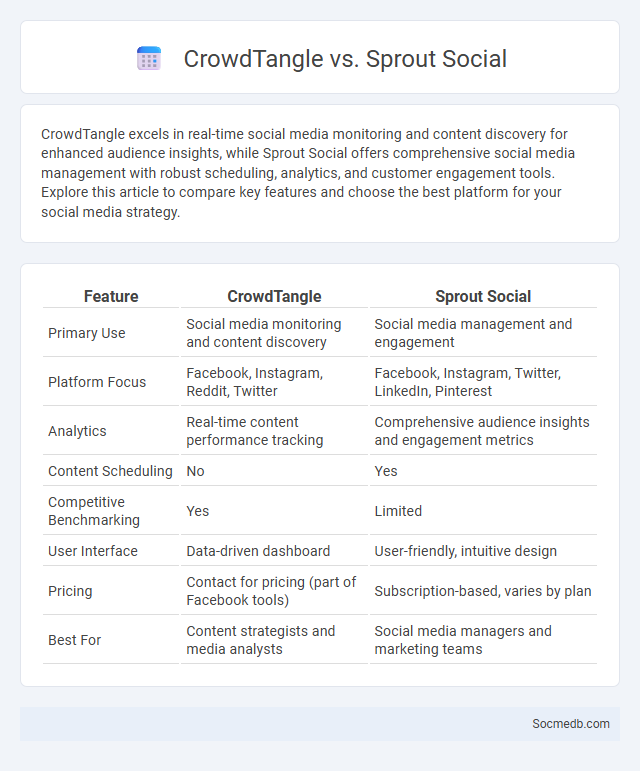
Photo illustration: CrowdTangle vs Sprout Social
CrowdTangle excels in real-time social media monitoring and content discovery for enhanced audience insights, while Sprout Social offers comprehensive social media management with robust scheduling, analytics, and customer engagement tools. Explore this article to compare key features and choose the best platform for your social media strategy.
Table of Comparison
| Feature | CrowdTangle | Sprout Social |
|---|---|---|
| Primary Use | Social media monitoring and content discovery | Social media management and engagement |
| Platform Focus | Facebook, Instagram, Reddit, Twitter | Facebook, Instagram, Twitter, LinkedIn, Pinterest |
| Analytics | Real-time content performance tracking | Comprehensive audience insights and engagement metrics |
| Content Scheduling | No | Yes |
| Competitive Benchmarking | Yes | Limited |
| User Interface | Data-driven dashboard | User-friendly, intuitive design |
| Pricing | Contact for pricing (part of Facebook tools) | Subscription-based, varies by plan |
| Best For | Content strategists and media analysts | Social media managers and marketing teams |
Overview: CrowdTangle vs Sprout Social
CrowdTangle specializes in social media content discovery and performance tracking, enabling users to monitor viral content trends and competitor engagement primarily on Facebook, Instagram, and Reddit. Sprout Social offers a comprehensive social media management platform with features like scheduling, audience engagement, analytics, and customer relationship management across multiple networks including Twitter, LinkedIn, and Instagram. While CrowdTangle excels in real-time content insights and trend analysis, Sprout Social focuses on streamlining social media workflows and enhancing communication strategies for businesses.
Key Features Comparison
Social media platforms vary significantly in features, with Facebook offering comprehensive user profiles and extensive community groups, while Instagram prioritizes visual content through photos and short videos. Twitter excels in real-time news updates and concise messaging, whereas LinkedIn focuses on professional networking and career development. Your choice depends on whether you value detailed user interaction, visual storytelling, rapid information sharing, or business connections.
Social Media Monitoring Capabilities
Social media monitoring capabilities enable businesses to track brand mentions, customer sentiment, and market trends in real-time across platforms such as Twitter, Facebook, and Instagram. Advanced analytics tools utilize natural language processing (NLP) and machine learning algorithms to identify key influencers, detect emerging crises, and measure campaign effectiveness. These insights support strategic decision-making, enhance customer engagement, and optimize marketing efforts by providing actionable data on user behavior and competitive activity.
Analytics and Reporting Tools
Social media analytics and reporting tools provide in-depth insights into audience behavior, engagement patterns, and campaign performance, enabling data-driven decision-making. Platforms like Hootsuite, Sprout Social, and Google Analytics offer real-time monitoring, sentiment analysis, and customizable reports to optimize content strategy. Effective use of these tools enhances ROI by identifying key metrics such as reach, impressions, click-through rates, and follower growth trends.
Content Discovery and Curation
Content discovery and curation on social media platforms enhance user engagement by leveraging advanced algorithms to surface personalized topics, trending posts, and niche communities. Effective curation tools aggregate relevant content from diverse sources, promoting quality over quantity and fostering meaningful interactions. Data-driven insights enable brands and influencers to optimize content strategies, increasing visibility and audience retention.
User Interface and Ease of Use
Social media platforms prioritize intuitive User Interface (UI) designs that enhance user engagement by simplifying navigation and content discovery. Features such as customizable feeds, interactive icons, and streamlined menus improve ease of use, making it effortless for users to connect and share information. Responsive design across devices ensures consistent accessibility, contributing to a seamless social media experience.
Integration with Other Platforms
Social media platforms increasingly prioritize seamless integration with other digital services to enhance user experience and streamline content sharing. Features such as cross-platform posting, single sign-on authentication, and API connectivity enable businesses and individuals to synchronize campaigns and manage interactions efficiently across multiple channels. This interconnected ecosystem drives higher engagement rates and expands reach by leveraging the strengths of diverse platforms like Instagram, Facebook, Twitter, and LinkedIn.
Pricing and Subscription Plans
Social media platforms offer a variety of pricing and subscription plans tailored to different user needs, ranging from free basic accounts to premium tiers with advanced features like analytics, advertising tools, and enhanced security. Platforms such as LinkedIn Premium, Facebook Business Suite, and Twitter Blue provide monthly or annual subscription models, often including benefits like increased visibility, audience targeting, and priority support. Pricing varies widely, with entry-level plans typically starting around $5 to $30 per month, while enterprise solutions can exceed several hundred dollars, reflecting the scope of features and scalability required by businesses and professional users.
Pros and Cons of Each Tool
Facebook offers robust community-building features and targeted advertising but struggles with privacy concerns and misinformation spread. Instagram excels in visual content sharing and influencer marketing, yet faces challenges with user mental health and algorithmic bias. Twitter facilitates real-time news and public discourse, while dealing with issues like harassment, misinformation, and character limits.
Choosing the Best Platform for Your Needs
Selecting the best social media platform depends on your target audience, content type, and business objectives. For B2B marketing, LinkedIn offers robust networking and lead generation tools, while Instagram excels in visual storytelling ideal for lifestyle brands. Understanding platform demographics and engagement metrics ensures alignment with marketing goals and maximizes ROI.
 socmedb.com
socmedb.com